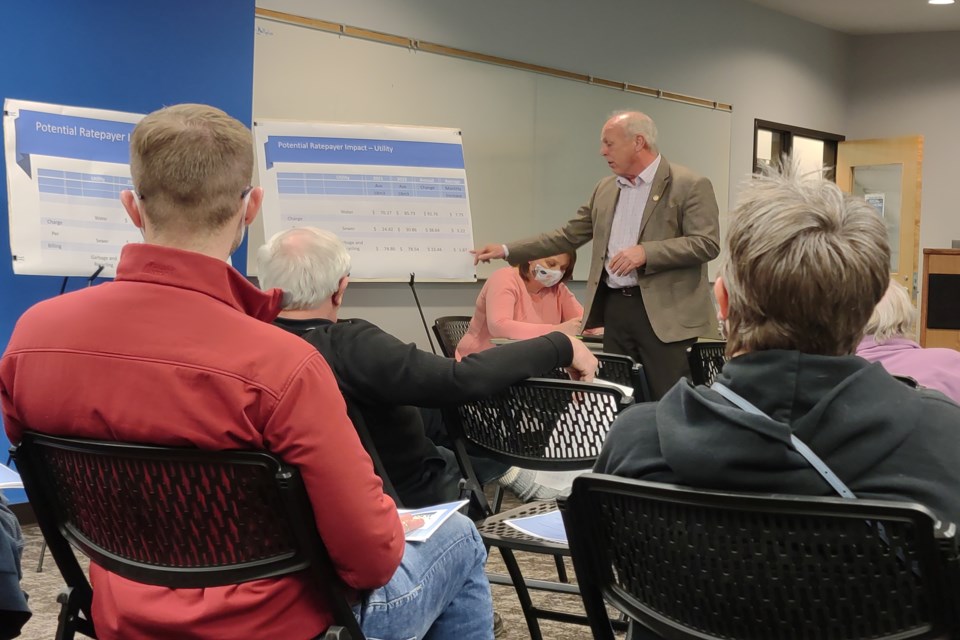Editor's note: The print version of this article was published with an error in the second headline, which has now been corrected. We apologize for the error.
ATHABASCA – Athabasca residents set their eyes on the town’s proposed budget for 2022 last week and had a chance to provide their own feedback in-person to council and administration regarding tax increases and levels of service in the community.
There were about 20 in attendance at the Athabasca Regional Multiplex Feb. 23 as administration and councillors hosted an open house to fill residents in on some of the factors that went into crafting this year’s capital and operating budgets, which have yet to be finalized as this year’s assessment and provincial budget numbers only came in late last week.
Mayor Rob Balay introduced chief financial officer Jeff Dalley “to point out some of the challenges that council and administration faced this year that are new this year compared to previous budgets.”
Dalley prefaced his presentation with some basics, pointing out a municipal operating budget takes care of salaries, contracted services, maintenance, supplies and debt servicing. A capital budget on the other hand pays for physical assets over $5,000 such as equipment, fleet vehicles, town facilities, roads, parks and utility infrastructure.
He noted proposed operating expenditures of $10.269 million, a 9.1 per cent decrease from 2021, as well as a 10.64 per cent decrease in operating revenues to $8.92 million. He also pointed out a 57 per cent decrease in federal and provincial grant funding — Municipal Sustainability Initiative (MSI) funding for instance will fall to just $497,036 in 2022.
That, along with zero per cent growth in property assessments, fewer business startups, rising inflation, rising insurance rates, a three per cent cost-of-living increase for staff, and increased franchise fees and water commission rates add up to a proposed property tax increase of 2.5 per cent for residential and 1.5 per cent for non-residential.
Capital projects
Capital expenditures for 2022 will see $150,000 each go toward a sewage lift station electrical replacement and an aerator diffuser and float/sink replacement at the wastewater treatment facility.
The allotment for vehicles and equipment comes in at $100,000 while $50,000 will be put toward both an extrication tool replacement and a new storm drain. Weigh scales and new financial software will each cost $15,000, while $85,000 has been set aside for various projects at the Multiplex to take advantage of a CFEP grant from the province which matches the amount of money a group contributes to a project.
There was also carry-over from 2021 with $25,000 set aside for Jubilee Booster Station project paving, and $45,000 for a new vehicle for the community peace officer.
Police spending
Policing costs are expected to rise to $116,350, up from $87,326 in 2021. They will continue to increase to $174,652 for 2023 and 2024 and will have a direct effect on residential tax rates, said Dalley.
“Starting in 2020 the provincial government came out and said that for the next five years, municipalities are going to be paying additional policing costs,” said Dalley.
Colleen Powell picked up where she left off as mayor in October regarding policing costs, saying she is still perturbed by the downloading from the province and that it can’t be shown as a requisition, so comes back on the municipality to explain to ratepayers.
“By the provincial regulations, that money was put directly on the property taxes … and that amount of money cannot be shown as a requisition,” she said.
“We’re allowed to show that on a tax receipt or tax invoice that you get, but of course the government doesn't want us to show that on there because it's unfavourable,” said mayor Balay, adding the provincial government is trying to recoup some of the 70 per cent it contributes to policing costs, while the federal government contributes 30 per cent.
Franchise fees
Some in attendance also took issue with rising franchise fees.
“I understand the rationale for the franchise fee is to see funding from non-taxable properties,” said Lionel Cherniwchan, another former Athabasca mayor. “But while you're getting non-taxable properties, you’re also getting the ratepayers.”
Franchise fees have indeed increased several times in the last few years, as Cherniwchan pointed out, with the latest increases coming this year when both the AltaGas and Fortis fees were increased two per cent each to 14 per cent.
“One of the reasons that we chose to do that is because then we get revenue from places like the university, from the churches and people that don't pay taxes, and it's our way of collecting from them instead of passing that on,” said Balay. “We have to get the money from somewhere and in this budget, we reduce expenses from the previous year by over 10 per cent and that was not an easy thing to do.
Water rate increase
Ratepayers will also see increases in their utility bills, as the costs of providing those services are rising fast.
Residents will see a 15.25 per cent increase in water rates; a 17.56 per cent increase in sewer rates; and a 5.11 per cent increase for garbage and recycling.
Coun. Dave Pacholok, who also chairs the Aspen Regional Water Services Commission, explained that most of the increase in water rates is a result of the water commission increasing its rates in an effort to start rebuilding reserves after contributing to the new raw water intake system.



